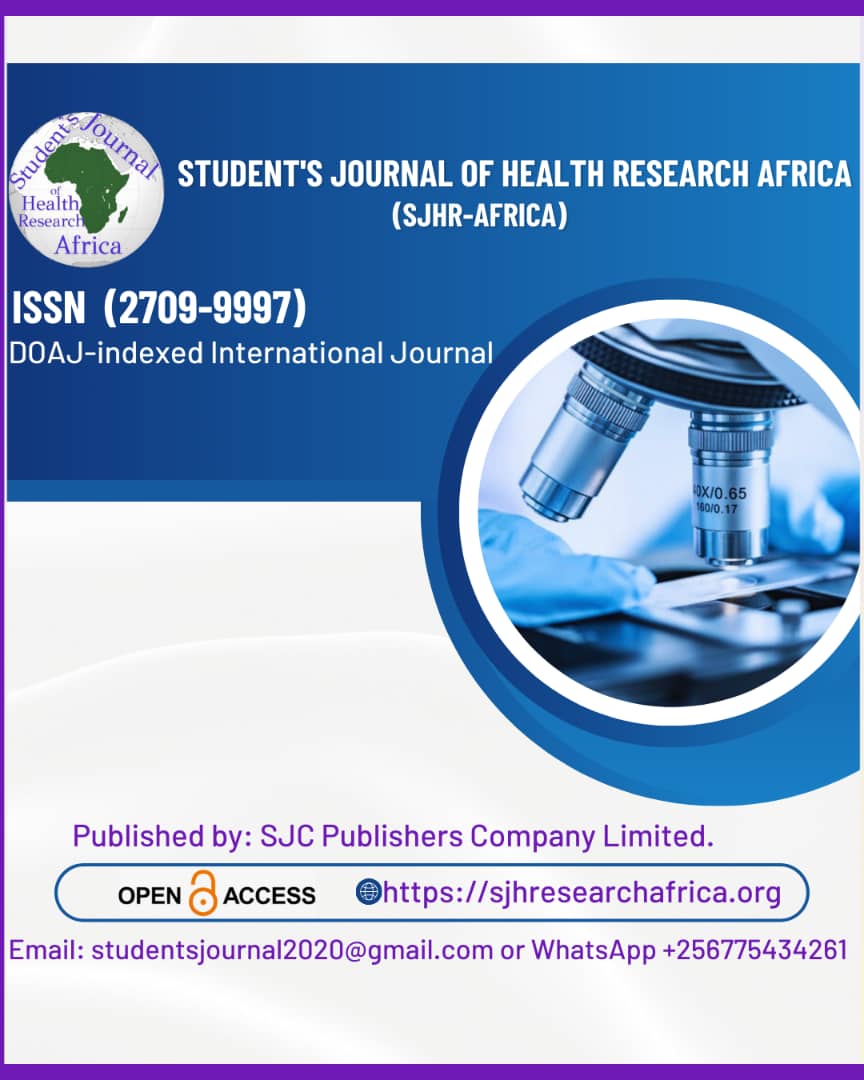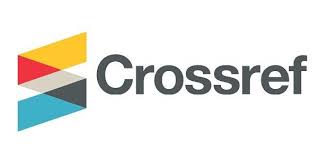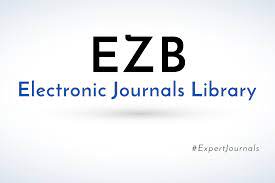Effect of educational intervention on knowledge and skills of bachelor nursing completion students towards Paediatric emergency triage at Jinja, Mbarara University of Science and Technology. A cross-sectional study.
DOI:
https://doi.org/10.51168/sjhrafrica.v6i9.2049Keywords:
Educational intervention, Knowledge and skills, Paediatric emergency triage, Bachelor of Nursing students, Nursing education, Clinical competence, Mbarara University of Science and Technology (MUST), Emergency Triage systemsAbstract
Background:
Despite the government’s efforts to train in-service nurses, the knowledge of student nurses towards the use of ETAT+, a WHO tool for the rapid identification and management of emergency pediatric patients, is limited. The study aimed to assess the baseline knowledge and skills, as well as the effect of an educational intervention, on the knowledge and skills of Bachelor of Nursing Completion (BNC) students regarding emergency Paediatric triage at Jinja campus, MUST.
Methods:
A pre-posttest quasi-experimental design using quantitative methods was employed among 30 second-year BNC students at MUST–Jinja Campus. Consecutive sampling was applied. Baseline knowledge was assessed using a WHO-adapted questionnaire, and skills were evaluated through a simulation-based checklist. Participants underwent a one-and-a-half-hour lecture-based ETAT+ training and simulation session, followed by a post-intervention assessment after two weeks. Data was analyzed using STATA 17.0 with the Wilcoxon signed-rank and Mann-Whitney U tests, with significance set at p<0.05.
Results:
(53.3%) Of the respondents were males, (63.3% reported having ever worked in an emergency department and only 20% of the participants reported having ever received triage training. At baseline, none of the students achieved satisfactory knowledge or skills scores (≥60%). The mean pretest knowledge score was 47% (SD 7), while skills scored a mean of 40% (SD 8). Post-intervention, knowledge scores significantly improved by 46.16%, from a median of 46.15% to 92.31% (Wilcoxon p<0.0001). Similarly, skills demonstrated marked improvement across domains, including patient assessment, communication, and clinical judgment, with overall competence significantly higher than baseline (p<0.05).
Conclusion:
The educational intervention using lecture and simulation-based training significantly improved both knowledge and skills of BNC students in pediatric emergency triage.
Recommendation:
Integration of ETAT+ training into the nursing curriculum and regular refresher simulations and continuous assessment are essential to ensure sustained knowledge and skills among student nurses and future practitioners.
References
AL., A. E. 2017. Nursing skill mix in European hospitals. BMJ, 26(7):559-568.
ALLEN, A. R., SPITTAL, M. J., NICOLAS, C., OAKLEY, E. & FREED, G. L. 2015. Accuracy and interrater reliability of paediatric emergency department triage. Emergency Medicine Australasia, 27, 447-452.
ALOYCE, R., LESHABARI, S. & BRYSIEWICZ, P. 2014. Assessment of knowledge and skills of triage amongst nurses working in the emergency centres in Dar es Salaam, Tanzania. African Journal of Emergency Medicine, 4, 14-18.
ANDERSEN, T. & WATKINS, K. 2018. The value of peer mentorship as an educational strategy in nursing. Journal of Nursing Education, 57, 217-224.
AZHOUGH, R., SHAMS VAHDATI, S., FARAJI, F., FARAJI, M., GHORBANIAN, M., RAMOUZ, A. & TAJODDINI, S. 2015. A one-day triage course for nurses is essential. Journal of Emergency Practice and Trauma, 1, 52-55.
BARATA, I., BROWN, K. M., FITZMAURICE, L., GRIFFIN, E. S., SNOW, S. K., MEDICINE, A. A. O. P. C. O. P. E., COMMITTEE, A. C. O. E. P. P. E. M., COMMITTEE, E. N. A. P., SHOOK, J. E., ACKERMAN, A. D., CHUN, T. H., CONNERS, G. P., DUDLEY, N. C., FUCHS, S. M., GORELICK, M. H., LANE, N. E., MOORE, B. R., WRIGHT, J. L., BENJAMIN, L. S., ALADE, K., ARMS, J., AVARELLO, J. T., BALDWIN, S., CANTOR, R. M., COHEN, A., DIETRICH, A. M., EAKIN, P. J., GAUSCHE-HILL, M., GERARDI, M., GRAHAM, C. J., HOLTZMAN, D. K., HOM, J., ISHIMINE, P., JINIVIZIAN, H., JOSEPH, M., MEHTA, S., OJO, A., PAUL, A. Z., PAUZE, D. R., PEARSON, N. M., ROSEN, B., RUSSELL, W. S., SAIDINEJAD, M., SLOAS, H. A., SCHWARTZ, G. R., SWENSON, O., VALENTE, J. H., WASEEM, M., WHITEMAN, P. J., WOOLRIDGE, D., VICIOSO, M., HERRIN, S. A., NAGLE, J. T., CADWELL, S. M., GOODMAN, R. L., JOHNSON, M. L. & FRANKENBERGER, W. D. 2015. Best Practices for Improving Flow and Care of Pediatric Patients in the Emergency Department. Pediatrics, 135, e273-e283.
CHIUME, M., ECKERLE, M., CROUSE, H. L., PHIRI, A., KAZEMBE, P. N., FRIESEN, H., MVALO, T., RUS, M., FITZGERALD, E., HOFFMAN, I., SCHUBERT, C., & MCKENNEY, A. 2018. Building sustainable partnerships to strengthen pediatric capacity at a government hospital in Malawi. Pediatrics, 142, 510-510.
HATHCOCK, A. M., EDWARDS-JACKSON, N., CHIUME, M., ECKERLE, M., SCHUBERT, C., CROUSE, H. L. & KAZEMBE, P. N. 2018. Development of a locally-relevant resuscitation training curriculum in Malawi. Pediatrics, 142, 520-520.
HELIYON 2024. Pre-service Nurses' Experiences of Simulated Health Education Classes. PubMed Central, e27703. https://www.ncbi.nlm.nih.gov/pmc/articles/PMC4771226/ (Accessed: 22 August 2025).
Hu, F., Yang, J., Yang, B.X., Zhang, F.J., Yu, S.H., Liu, Q., Wang, A.L., Luo, D., Zhu, X.P. and Chen, J., 2021. The impact of simulation-based triage education on nursing students' self-reported clinical reasoning ability: A quasi-experimental study. Nurse Education in Practice, 50, p.102949.
JAVADI, S., SALIMI, T., SAREBAN, M. T. & DEHGHANI, M. A. 2016. Knowledge and practice of nurses regarding patients’ triage in the emergency department. Iranian journal of emergency medicine, 3, 15-22.
MALYON, L., WILLIAMS, A. & WARE, R. S. 2014. The Emergency Triage Education Kit: Improving paediatric triage. Australasian Emergency Nursing Journal, 17, 51-58.
NEUMBE, I. M., SSENYONGA, L., SOITA, D. J., IRAMIOT, J. S. & NEKAKA, R. 2023. Attitudes and perceptions of undergraduate nursing students towards the nursing profession. PLOS ONE, 18, e0280700.
OLSSON, M., , A. S. & , H., ANDERSSON AT, ET . 2022. Educational intervention in triage with the Swedish triage scale RETTS©, with focus on specialist nurse students in ambulance and emergency care. International Emergency Nursing, 101194..
RAHMANI, F., M., PS & E., AL. 2018. Evaluating the accuracy of emergency triage by nurses. Journal of emergency practice and trauma, 9-13.
RAHMATI, H., AZMOON, M., MEIBODI, M. K. & ZARE, N. 2013. Effects of triage education on knowledge, practice, and qualitative index of emergency room staff: A quasi-interventional study. Bulletin of Emergency & Trauma, 1, 69-75. Available at: https://www.ncbi.nlm.nih.gov/pmc/articles/PMC4771226/ (Accessed: 22 August 2025).
RECZNIK, C., T. & SIMKO, L., M. 2018a. (Pediatric triage education: an integrative literature review. journal of emergency of emergency nursing, 44(6):605-13.
RECZNIK, C. T., SIMKO, L. C., TRAVERS, D. & DEVIDO, J. 2019. Pediatric Triage Education for the General Emergency Nurse: A Randomized Crossover Trial Comparing Simulation With Paper-Case Studies. Journal of Emergency Nursing, 45, 394-402.
RECZNIK, C. T. & SIMKO, L. M. 2018b. Pediatric triage education: an integrative literature review. Journal of Emergency Nursing, 44, 605-613.
Research Article 10. Journal of Comprehensive Pediatrics. Available at: https://brieflands.com/articles/jcp-80846#abstract (Accessed: 21 August 2025).
RICE, B., PERIYANAYAGAM, U., CHAMBERLAIN, S., DREIFUSS, B., HAMMERSTEDT, H., NELSON, S., MALING, S. & BISANZO, M. 2016. Mortality in children under five receiving nonphysician clinician emergency care in Uganda. Pediatrics, 137.
ROBISON, J. A., AHMAD, Z. P., NOSEK, C. A., DURAND, C., NAMATHANGA, A., MILAZI, R., THOMAS, A., SOPRANO, J. V., MWANSAMBO, C., KAZEMBE, P. N. & TORREY, S. B. 2012. Decreased Pediatric Hospital Mortality After an Intervention to Improve Emergency Care in Lilongwe, Malawi. Pediatrics, 130, e676-e682.
SHEHAB, M., ALI, M. & MAHMOUD ABD-EL-KADER, H. 2017. Effect of an educational program regarding patients’ triage on nurses’ knowledge and skills at the emergency department. World Journal of Nursing Sciences, 3, 163-69.
TUYISENGE, L., KYAMANYA, P., VAN STEIRTEGHEM, S., BECKER, M., ENGLISH, M. & LISSAUER, T. 2024. Knowledge and skills retention following Emergency Triage, Assessment and Treatment plus Admission course for final year medical students in Rwanda: a longitudinal cohort study. BMJ, 993-997.
WHO 2013; 2016. The strategy is contributing to reductions in global child mortality by an estimated 15%. GENEVA: WHO.
YAZDANNIK, A., DSATJERDI, E. I. & MOHAMADIRIZI, S. 2018. Utilizing mobile health methods to improve emergency nurses’ knowledge about the Emergency Severity Index triage. Journal of Education and Health Promotion, 7, 10.
Agyeman-Yeboah, J., Korsah, K. A., & Okrah, J. (2017). Factors that influence the clinical utilization of the nursing process at a hospital in Accra, Ghana. BMC Nursing, 16, 30. https://doi.org/10.1186/s12912-017-0228-0
Al Mutair, A., Al Bazroun, M. I., Almusalami, E. M., Aljarameez, F., Alhasawi, A. I., Alahmed, F., Saha, C., Alharbi, H. F., & Ahmed, G. Y. (2022). Quality of Nursing Work Life among Nurses in Saudi Arabia: A Descriptive Cross-Sectional Study. Nursing Reports, 12(4), 1014–1022. https://doi.org/10.3390/nursrep12040097
AlShatarat, M., Rayan, A., Eshah, N. F., Baqeas, M. H., Jaber, M. J., & ALBashtawy, M. (2022). Triage Knowledge and Practice and Associated Factors Among Emergency Department Nurses. SAGE Open Nursing, 8, 23779608221130588. https://doi.org/10.1177/23779608221130588
Bijani, M., & Khaleghi, A. A. (2019). Challenges and Barriers Affecting the Quality of Triage in Emergency Departments: A Qualitative Study. Galen Medical Journal, 8, e1619. https://doi.org/10.31661/gmj.v8i0.1619
Dekker-Boersema, J., Hector, J., Jefferys, L. F., Binamo, C., Camilo, D., Muganga, G., Aly, M. M., Langa, E. B. R., Vounatsou, P., & Hobbins, M. A. (2019). Triage conducted by lay staff and emergency training reduces paediatric mortality in the emergency department of a rural hospital in Northern Mozambique. African Journal of Emergency Medicine, 9(4), 172–176. https://doi.org/10.1016/j.afjem.2019.05.005
Elgazzar, S. (2023). Knowledge of triage and its correlated factors among Emergency Department Nurses. Egyptian Journal of Health Care. https://doi.org/10.21608/EJHC.2021.270296
Filippi, V., Chou, D., Ronsmans, C., Graham, W., & Say, L. (2016). Levels and Causes of Maternal Mortality and Morbidity. In R. E. Black, R. Laxminarayan, M. Temmerman, & N. Walker (Eds.), Reproductive, Maternal, Newborn, and Child Health: Disease Control Priorities, Third Edition (Volume 2). The International Bank for Reconstruction and Development / The World Bank. http://www.ncbi.nlm.nih.gov/books/NBK361917/
FitzGerald, G., Jelinek, G. A., Scott, D., & Gerdtz, M. F. (2010). Emergency department triage revisited. Emergency Medicine Journal: EMJ, 27(2), 86–92. https://doi.org/10.1136/emj.2009.077081
Graham, H. R., Kamuntu, Y., Miller, J., Barrett, A., Kunihira, B., Engol, S., Kabunga, L., Lam, F., Olaro, C., Ajilong, H., & Kitutu, F. E. (2022). Hypoxaemia prevalence and management among children and adults presenting to primary care facilities in Uganda: A prospective cohort study. PLOS Global Public Health, 2(4), e0000352. https://doi.org/10.1371/journal.pgph.0000352
Hands, C., Hands, S., Verriotis, M., Bunn, J., Bailey, E., Samuels, R. J., Sankoh, K., Mustapha, A., Williams, B., & Taylor, S. (2021). Emergency Triage Assessment and Treatment Plus (ETAT+): Adapting training to strengthen quality improvement and task-sharing in emergency paediatric care in Sierra Leone. Journal of Global Health, 11, 04069. https://doi.org/10.7189/jogh.11.04069
Hategeka, C., Mwai, L., & Tuyisenge, L. (2017). Implementing the Emergency Triage, Assessment and Treatment plus admission care (ETAT+) clinical practice guidelines to improve quality of hospital care in Rwandan district hospitals: Healthcare workers’ perspectives on relevance and challenges. BMC Health Services Research, 17, 256. https://doi.org/10.1186/s12913-017-2193-4
Hategeka, C., Shoveller, J., Tuyisenge, L., Kenyon, C., Cechetto, D. F., & Lynd, L. D. (2017). Pediatric emergency care capacity in a low-resource setting: An assessment of district hospitals in Rwanda. PLOS ONE, 12(3), e0173233. https://doi.org/10.1371/journal.pone.0173233
Novakowski, S. K., Kabajaasi, O., Kinshella, M.-L. W., Pillay, Y., Johnson, T., Dunsmuir, D., Pallot, K., Rigg, J., Kenya-Mugisha, N., Opar, B. T., Ansermino, J. M., Tagoola, A., & Kissoon, N. (2022). Health worker perspectives of Smart Triage, a digital triaging platform for quality improvement at a referral hospital in Uganda: A qualitative analysis. BMC Pediatrics, 22(1), 593. https://doi.org/10.1186/s12887-022-03627-1
Snoswell, C. L., Chelberg, G., De Guzman, K. R., Haydon, H. M., Thomas, E. E., Caffery, L. J., & Smith, A. C. (2023). The clinical effectiveness of telehealth: A systematic review of meta-analyses from 2010 to 2019. Journal of Telemedicine and Telecare, 29(9), 669–684. https://doi.org/10.1177/1357633X211022907
Tesfa, D., Tiruneh, S. A., Azanaw, M. M., Gebremariam, A. D., Engdaw, M. T., Kefale, B., Abebe, B., & Dessalegn, T. (2021). Time to death and its determinants among under-five children in Sub-Saharan Africa using the recent (2010–2018) demographic and health survey data: Country-based shared frailty analyses. BMC Pediatrics, 21(1), 515. https://doi.org/10.1186/s12887-021-02950-3
World Health Organization. (2016). Updated guideline: Paediatric emergency triage, assessment and treatment: care of critically-ill children. World Health Organization. https://iris.who.int/handle/10665/204463
World health statistics 2016: Monitoring health for the SDGs, sustainable development goals. (n.d.). Retrieved September 13, 2025, from https://www.who.int/publications/i/item/9789241565264
Yancey, C. C., & O’Rourke, M. C. (2025). Emergency Department Triage. In StatPearls. StatPearls Publishing. http://www.ncbi.nlm.nih.gov/books/NBK557583/
Downloads
Published
How to Cite
Issue
Section
License
Copyright (c) 2025 Lilian Ajuna, Valence Niyonzima

This work is licensed under a Creative Commons Attribution-NonCommercial-NoDerivatives 4.0 International License.





















